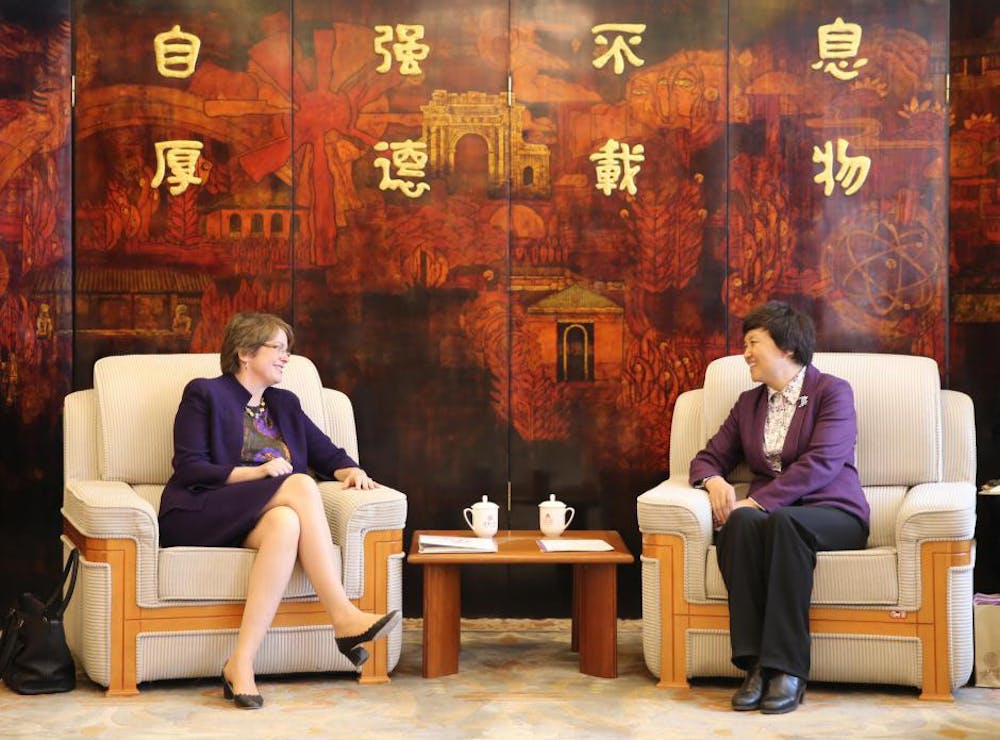President Christina Paxson P’19 travelled to China during spring break to demonstrate the University’s commitment to building substantive and collaborative partnerships with Chinese universities, Paxson said. She spoke at Tsinghua University in Beijing and Fudan University in Shanghai during her trip.
Her visit was not only “to signal to universities, government officials, academics and researchers that we are serious about these collaborations,” but also to meet with alums, students and parents to show that “we’re serious about trying to attract talent,” said Professor Edward Steinfeld, who is the director of the Watson Institute for International and Public Affairs and the Brown China Initiative and accompanied Paxson on the trip.
“China is increasingly important to Brown,” Paxson said, adding that the largest group of international students for both undergraduate and graduate students is from China.
Paxson visited these two universities for the first time because the University already has existing research relationships with them, Steinfeld said.
“Both are the cream of the crop,” said Max Song ’15.5, who spoke to Paxson before her trip because of his previous involvement in Chinese projects and scholarship, such as with the Year of China and as a Schwarzman Scholar.
“If you want to develop your presence, you start from the top and go down,” Song said, adding that Tsinghua is “like the Harvard or Massachusetts Institute of Technology of China.”
Moreover, Tsinghua and Fudan offered “important platforms,” Steinfeld said. The talks will be heard beyond the students and faculty members of those campuses, he added.
Steinfeld also noted that these two universities are trying to become more like a “modern liberal arts research university along American lines.”
“These institutions are looking to universities like Brown,” Paxson said. “They’re thinking about how to cultivate creativity and move away from a rigid system.”
Paxson also met with Yang Wei ’85, a graduate of the University’s PhD program in engineering, who currently leads the National Natural Science Foundation of China. The purpose of that visit was to “learn how the Chinese NSF is developing collaborations internationally with the United States and other countries,” Paxson said.
If the NSF and National Institutes of Health create more calls for research proposals from American and Chinese universities, then “we might be able to use that to build stronger connections with Chinese universities,” Paxson said.
Paxson received “great enthusiasm” at the talks and alumni events, Steinfeld said. He observed that there were many undergraduates present at the lectures who were eager to ask questions. Some students asked about the open curriculum. There were also questions about the experience of a woman being a leading researcher, he said.
The audiences “were lively and a lot of fun,” Paxson said.
At the alumni events in Beijing and Shanghai, Paxson gave a lecture on “the importance of the Brown education,” said Song, whose parents attended the event in Beijing.
“They’re hungry to learn about what’s going on at the University,” Paxson said.
Paxson not only met with alums and parents of current students, but also students admitted to the class of 2020 through early decision, she said.
Through speaking with admitted students, Paxson said she learned of the advantage of translating some of the University’s admission materials into Chinese for the parents of students.
It was important for people at the universities and alumni events “to see that Paxson is not just a university president but also an economist, which showed the University in a positive light,” Steinfeld said.
Moving forward, this visit is a first step in building international connections that reflect the University’s investments in research and education, Paxson said. The best partnerships are different for different areas of scholarship, so “having a single partnership (to one university) does not yield richer connections,” she added.
“We want solid, substantive relationships with these universities, but we’re willing to be patient for it to happen,” Paxson said.
“I don’t think establishing a brick-and-mortar center is a good idea — at least not yet,” she said, adding that some other peer institutions that have created centers in cities in China have found them to be not as successful as they would have wanted.
Currently, the Watson Institute is important as “an anchor for a lot of the work with China at Brown,” Paxson said, adding that she hopes Steinfeld’s work in the China Initiative will be a China center where scholars and students can gather for events and lectures to learn more about the country.
Song envisions a “grassroots approach” through which a general set of world problems is being tackled through different academic collaborations. This approach will allow the University to “increase the brand value of Brown in China” since the University is not prominently known yet in comparison to other Ivy League schools, he added. “I hope that Brown becomes a household name in China.”
The University already has existing research relationships in China that are spread out among many Chinese universities because “each of us is finding the best collaborator,” Steinfeld said. “In terms of investing infrastructure in China, we have to recognize that geographic and institutional diversity that we have.”
“We’re serious about building our reputation in China as a leading global liberal arts research university,” Steinfeld added.





